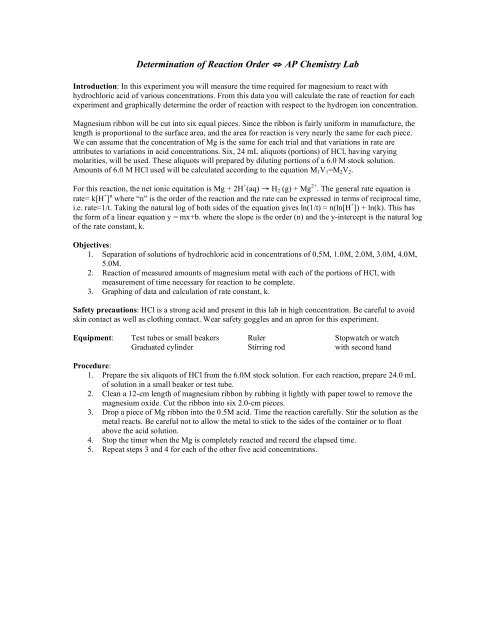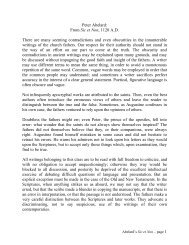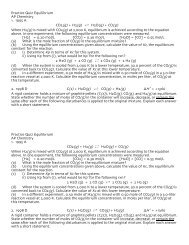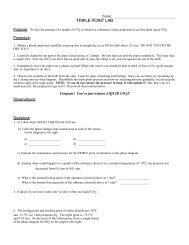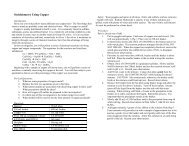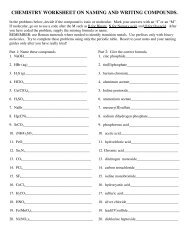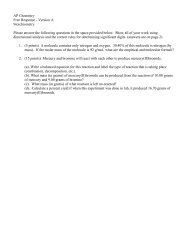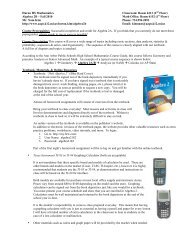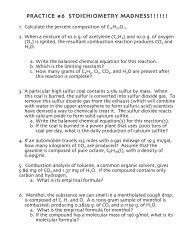Determination of Reaction Order â AP Chemistry Lab - Huron High ...
Determination of Reaction Order â AP Chemistry Lab - Huron High ...
Determination of Reaction Order â AP Chemistry Lab - Huron High ...
Create successful ePaper yourself
Turn your PDF publications into a flip-book with our unique Google optimized e-Paper software.
<strong>Determination</strong> <strong>of</strong> <strong>Reaction</strong> <strong>Order</strong> ⇔ <strong>AP</strong> <strong>Chemistry</strong> <strong>Lab</strong><br />
Introduction: In this experiment you will measure the time required for magnesium to react with<br />
hydrochloric acid <strong>of</strong> various concentrations. From this data you will calculate the rate <strong>of</strong> reaction for each<br />
experiment and graphically determine the order <strong>of</strong> reaction with respect to the hydrogen ion concentration.<br />
Magnesium ribbon will be cut into six equal pieces. Since the ribbon is fairly uniform in manufacture, the<br />
length is proportional to the surface area, and the area for reaction is very nearly the same for each piece.<br />
We can assume that the concentration <strong>of</strong> Mg is the same for each trial and that variations in rate are<br />
attributes to variations in acid concentrations. Six, 24 mL aliquots (portions) <strong>of</strong> HCl, having varying<br />
molarities, will be used. These aliquots will prepared by diluting portions <strong>of</strong> a 6.0 M stock solution.<br />
Amounts <strong>of</strong> 6.0 M HCl used will be calculated according to the equation M 1 V 1 =M 2 V 2 .<br />
For this reaction, the net ionic equitation is Mg + 2H + (aq) → H 2 (g) + Mg 2+ . The general rate equation is<br />
rate= k[H + ] n where “n” is the order <strong>of</strong> the reaction and the rate can be expressed in terms <strong>of</strong> reciprocal time,<br />
i.e. rate=1/t. Taking the natural log <strong>of</strong> both sides <strong>of</strong> the equation gives ln(1/t) = n(ln[H + ]) + ln(k). This has<br />
the form <strong>of</strong> a linear equation y = mx+b. where the slope is the order (n) and the y-intercept is the natural log<br />
<strong>of</strong> the rate constant, k.<br />
Objectives:<br />
1. Separation <strong>of</strong> solutions <strong>of</strong> hydrochloric acid in concentrations <strong>of</strong> 0.5M, 1.0M, 2.0M, 3.0M, 4.0M,<br />
5.0M.<br />
2. <strong>Reaction</strong> <strong>of</strong> measured amounts <strong>of</strong> magnesium metal with each <strong>of</strong> the portions <strong>of</strong> HCl, with<br />
measurement <strong>of</strong> time necessary for reaction to be complete.<br />
3. Graphing <strong>of</strong> data and calculation <strong>of</strong> rate constant, k.<br />
Safety precautions: HCl is a strong acid and present in this lab in high concentration. Be careful to avoid<br />
skin contact as well as clothing contact. Wear safety goggles and an apron for this experiment.<br />
Equipment: Test tubes or small beakers Ruler Stopwatch or watch<br />
Graduated cylinder Stirring rod with second hand<br />
Procedure:<br />
1. Prepare the six aliquots <strong>of</strong> HCl from the 6.0M stock solution. For each reaction, prepare 24.0 mL<br />
<strong>of</strong> solution in a small beaker or test tube.<br />
2. Clean a 12-cm length <strong>of</strong> magnesium ribbon by rubbing it lightly with paper towel to remove the<br />
magnesium oxide. Cut the ribbon into six 2.0-cm pieces.<br />
3. Drop a piece <strong>of</strong> Mg ribbon into the 0.5M acid. Time the reaction carefully. Stir the solution as the<br />
metal reacts. Be careful not to allow the metal to stick to the sides <strong>of</strong> the container or to float<br />
above the acid solution.<br />
4. Stop the timer when the Mg is completely reacted and record the elapsed time.<br />
5. Repeat steps 3 and 4 for each <strong>of</strong> the other five acid concentrations.
Data and Calculations:<br />
Trial Amount <strong>of</strong> 6.0M<br />
HCl diluted to<br />
24 mL<br />
1.<br />
[H + ] ln[H + ] Time <strong>of</strong><br />
reaction (t)<br />
(sec)<br />
1/t 1/[H + ]<br />
2.<br />
3.<br />
4.<br />
5.<br />
6.<br />
Carefully graph ln[H + ] on the y-axis and t on the x-axis, drawing a line <strong>of</strong> best fit. Use your calculator to<br />
perform a linear regression. Carefully graph 1/[H + ] on the y-axis and t on the x-axis, drawing a line <strong>of</strong> best<br />
fit. Use your calculator to perform a linear regression. Note: there are many other ways to represent this<br />
graph with the data/calculations listed above. It is up to you to understand the math and the relationships <strong>of</strong><br />
these variables to the line equation.<br />
Which graph is linear<br />
What is the slope <strong>of</strong> the graph<br />
What is the y-intercept<br />
What is the order <strong>of</strong> the reaction with respect to hydrogen ions<br />
Determine the value <strong>of</strong> the rate constant.<br />
Post-<strong>Lab</strong> Questions:<br />
1. Why does reaction rate usually change as the concentration changes<br />
2. Why does the reaction rate usually change with temperature<br />
3. What is the difference between reaction rate and specific rate constant<br />
4. How could you improve your data


